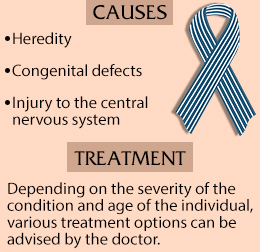Sclerosis of the spine is a state that involves hardening of tissues in the spinal cord or the vertebrae. The disorders causing such a condition as well as the symptoms and treatments associated with it have been described in the current article.

Sclerosis is a medical condition characterized by the hardening of body tissues. Different disorders that result due to sclerosis are multiple sclerosis, systemic sclerosis, amyotrophic lateral sclerosis (ALS) or Lou Gehrig's disease, osteosclerosis, otosclerosis, atherosclerosis, liver cirrhosis, lichen sclerosus, and many more depending on the tissue that gets affected. Sclerosis of the spine involves the hardening of either the spinal cord tissues or the bony vertebrae.
Causes
The disorders that involve sclerosis of the spine are multiple sclerosis, ALS, osteosclerosis, osteopetrosis and endplate sclerosis occurring in degenerative disc disease. The most common amongst these is multiple sclerosis. It is an autoimmune disorder wherein the myelin sheath of neurons gets inflamed, detached or even scarred. This affects the inter-neuron communication. Spinal cord abnormalities that occur due to multiple sclerosis are focal lesions and spinal cord atrophy (loss of axons).
ALS or Lou Gehrig's disease is characterized by deterioration of neurons in brain and spinal cord, which control muscular movements. The degeneration of neurons leads to scarring and sclerosis. Tuberous sclerosis involves tuber-like tumorous growth in the brain, skull, spine, skin, liver, and kidney. Osteosclerosis and osteopetrosis (Marble bone disease) involve the hardening of bones, and increase in bone density. Osteopetrosis is the result of dysfunction of osteoclasts, which are cells involved in bone reabsorption. In certain cases, the vertebrae of the spine undergo sclerosis, leading to abnormal fusion of adjacent vertebrae, and curvature of the spine (scoliosis).
Another common condition that involves sclerosis of the spine is endplate sclerosis that occurs in degenerative disc disease which is the result of wear and tear of the vertebral bones. Endplates are structures present on the top and bottom of each vertebra (except the sacral vertebrae), and are in direct contact with the intervertebral disc. The sclerosis of these endplates is associated with decreased blood supply to these structures.
Symptoms
Conditions characterized by sclerosis of the spinal cord lead to neurological symptoms like:
- Altered coordination in movements
- Numbness and/or weakness in arms and legs
- Tingling
- Muscle weakness
- Loss of balance
- Difficulty in breathing
- Tremors in the limbs
- Weight loss
Decreased attention span, hearing loss, memory loss, and depression can also be the result of spinal cord sclerosis.
Symptoms under conditions involving sclerosis of the vertebral bones include difficulty in sitting or standing straight, difficulty or pain while bending, twisting and lifting objects. When the vertebrae in the neck are affected, the person may experience severe pain in the neck and arms. In case the vertebrae of the lumbar region are affected, lower back pain and leg pain are experienced. However, some individuals may not experience any pain at all. Muscle contractions, cramps and weakness in muscles, spasticity (muscle stiffening), and head drop are the major symptoms in people suffering from ALS.
Diagnosis
Sclerosis and the resultant abnormalities can be diagnosed through imaging techniques like radiography, Magnetic Resonance Imaging (MRI) and Computed Tomography (CT). Bone sclerosis and increase in bone density can be identified through bone density tests. Blood tests and genetic tests are also performed to ensure the absence of any other disease, and identify genetic aberrations (if any), respectively.
Treatment
These disorders are not completely curable as of today. However, treatments are available to reduce their progression, and to deal with the symptoms associated with it. The treatment varies for each individual, and depends on the specific case and stage of disease progression. Common treatments include the prescription of immunomodulatory drugs like interferons as well as drugs to control muscle problems, and reduce nerve and bone damage. Apart from the medications, people suffering from spinal sclerosis may require physiotherapy and rehabilitative treatments. Some of the patients may even require support from nutritionists as well as psychologists to deal with their bodily and mental nutrition needs. Surgery can be an option in certain cases involving focal lesions.
Spinal sclerosis is a condition resulting due to a set of degenerative diseases affecting bones or the central nervous system. It leads to an array of neurological as well physical problems that need utmost attention and care. Early diagnosis and early treatment is crucial to prevent the progression of these diseases.
Disclaimer: This article is for informative purposes only, and should not be substituted for the advice of a medical professional.


 Sclerosis is a medical condition characterized by the hardening of body tissues. Different disorders that result due to sclerosis are multiple sclerosis, systemic sclerosis, amyotrophic lateral sclerosis (ALS) or Lou Gehrig's disease, osteosclerosis, otosclerosis, atherosclerosis, liver cirrhosis, lichen sclerosus, and many more depending on the tissue that gets affected. Sclerosis of the spine involves the hardening of either the spinal cord tissues or the bony vertebrae.
Sclerosis is a medical condition characterized by the hardening of body tissues. Different disorders that result due to sclerosis are multiple sclerosis, systemic sclerosis, amyotrophic lateral sclerosis (ALS) or Lou Gehrig's disease, osteosclerosis, otosclerosis, atherosclerosis, liver cirrhosis, lichen sclerosus, and many more depending on the tissue that gets affected. Sclerosis of the spine involves the hardening of either the spinal cord tissues or the bony vertebrae.